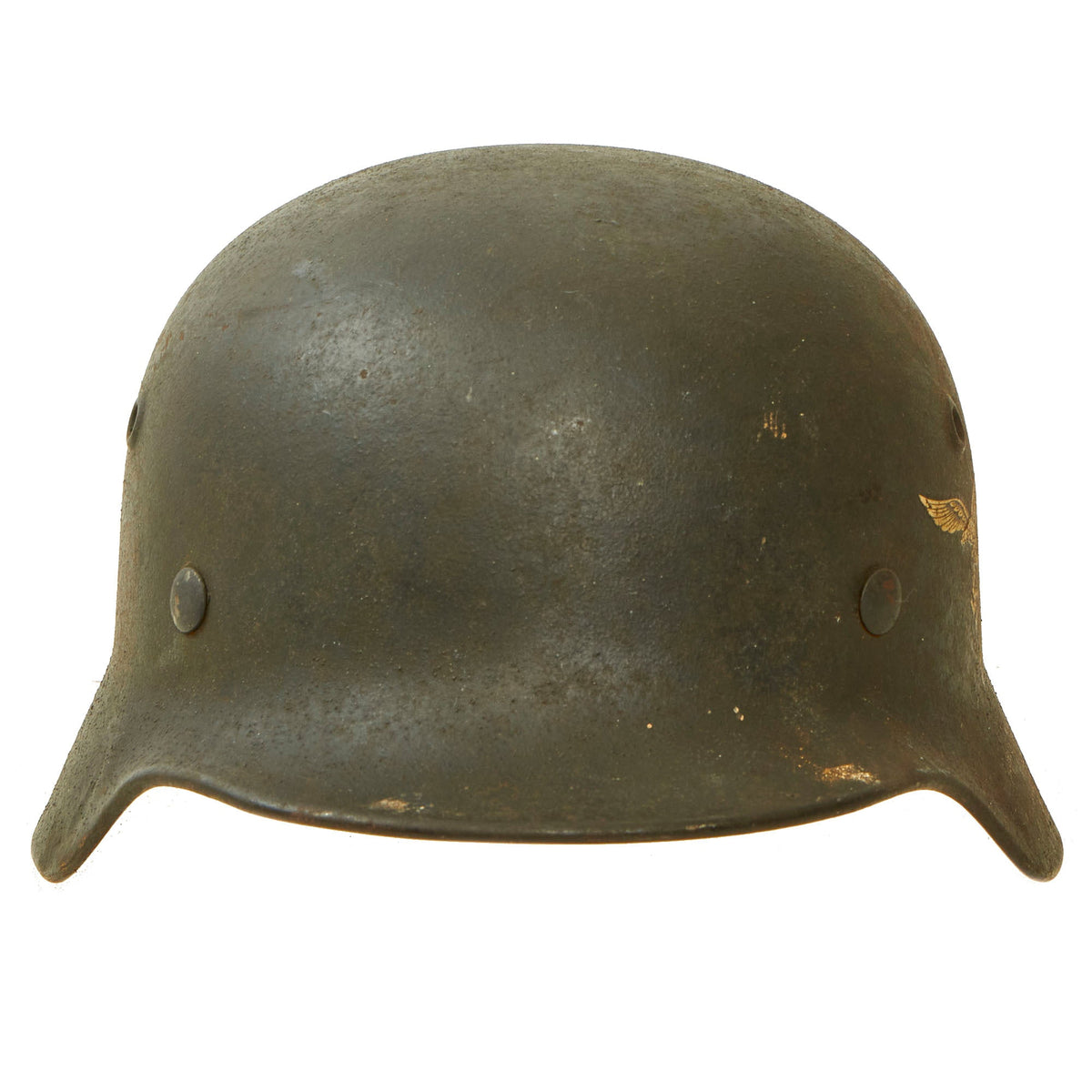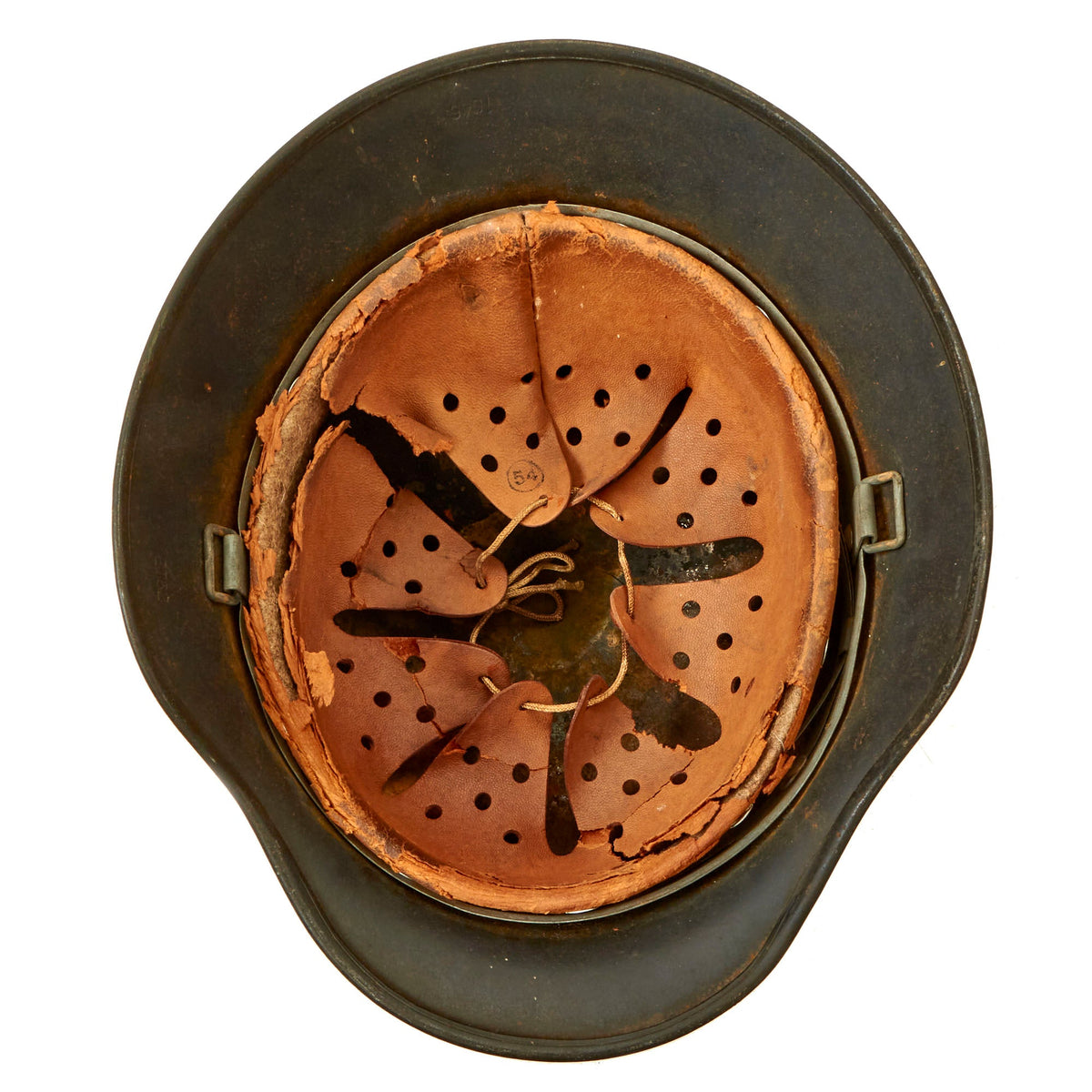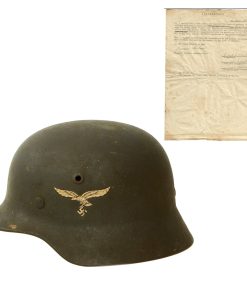Original German WWII M40 Single Decal Luftwaffe Helmet with USGI Bring Back Certificate & Damaged Liner – ET62 Original Items
$ 1.395,00 $ 348,75
Original Item: One of a Kind Set. This is a fantastic USGI bring back grouping from the European theater of WWII. As the saying goes, “To the Victor, The Spoils”, so USGIs brought home large amounts of material from WWII Germany. It was however regulated, and items were supposed to be inspected to make sure they did not have any intelligence value and were also appropriate to send back. Live grenades were definitely NOT an item that was wanted on the voyage with returning GI’s.
This set comes with a “CERTIFICATE” dated 11 OCT. 45, which is named to Cpl. PAUL J. LICHTY 13135873, and indicates that the items were mailed back to the United States. It is signed by a 1st Lt. Ord, who is listed as part of the 642 Materiel NY, which we believe refers to the 642nd Engineer Support Company based at Fort Drum, NY. The certificate indicates that the items have been checked and are all allowed to be brought back home, and lists the items as:
German Helmet
Field glass accessories
We do not know where the “field glass accessories” went, but they would have been useful in every day life, so were probably not kept as a collectible. The helmet definitely was.
We also have found the enlistment records of Paul J. Lichty, which indicate that he was born in 1922, and was a resident of Pennsylvania. He enlisted October 27, 1942 in Baltimore, and was listed as an airplane mechanic and repairman in his civilian occupation. With that type of experience he was understandably assigned to the U.S. Army Air Corps / Forces. We have not been able to find much about his life after the war, except that he passed away in 2015 at the age of 93 in Maryland. Definitely some great potential for further research.
The helmet in this set is a very nice all original example Model 1940 German WWII helmet with a single Luftwaffe Eagle decal and relic size 54cm liner. This stamped sheet steel construction helmet still retains almost all of the original lightly textured Luftwaffe Fliegerblau (flyer’s blue) paint, which utilized aluminum oxide as a texturing agent. There is scuffing and some scratches from service, but nothing major. The interior paint is very well retained, with just a bit of oxidation in areas. The original Luftwaffe eagle decal is still retained at almost 100%, showing a lovely aged toned color. This is really a fantastic decal, and we rarely see them this good!
The reverse, interior, neck guard apron is heat lot number stamped 1046 and the interior, left side, apron has the stamped manufacturer’s code and size, ET62 indicating that it was manufactured by Eisenhüttenwerk AG of Thale, located in the Harz district in Saxony, Germany. Size 62 is a nice smaller size that can accommodate liners from 54cm to 55cm or US 6 3/4 to 6 7/8.
All three original liner retaining pins are intact and in very good condition, retaining most of the original textured paint, with some chipping. The interior of the helmet still has its original leather liner with all 8 fingers present, however the leather has dry rotted, and how is in “relic” condition. The leather is in very delicate condition, and is torn through around the rim on the left side, with cracking and other deterioration throughout. The top tie string is still intact and threaded through all 8 fingers, but the liner should definitely be handled with care. There is still a clear size 54 stamp on one of the fingers. The outer side of the galvanized steel liner band over the left ear is marked 62 n.A / 54, indicating that this is a size 54 liner for a size 62 shell. The right side shows some traces of the maker marking, but there is a lot of “white rust”, which has made it illegible. There is no chinstrap included.
Overall an very good condition genuine complete M40 Single Decal Luftwaffe helmet, with a great USGI Bring Back paper! This is an item that will only continue to appreciate in value over time.
The first “modern” steel helmets were introduced by the French army in early 1915 and were shortly followed by the British army later that year. With plans on the drawing board, experimental helmets in the field, (“Gaede” helmet), and some captured French and British helmets the German army began tests for their own steel helmet at the Kummersdorf Proving Grounds in November, and in the field in December 1915. An acceptable pattern was developed and approved and production began at Eisen-und Hüttenwerke, AG Thale/Harz, (Iron and Foundry Works), in the spring of 1916.
These first modern M16 helmets evolved into the M18 helmets by the end of WWI. The M16 and M18 helmets remained in usage through-out the Weimar Reichswehr, (National Defence Force, Circa 1919-1933), era and on into the early years of the Third Reich until the development of the smaller, lighter M35 style helmet in June 1935.
In 1934 tests began on an improved Stahlhelm, whose design was a development of World War I models. The Eisenhüttenwerke company of Thale carried out prototype design and testing, with Dr. Friedrich Schwerd once again taking a hand.
The new helmet was pressed from sheets of molybdenum steel in several stages. The size of the flared visor and skirt was reduced, and the large projecting lugs for the obsolete armor shield were eliminated. The ventilator holes were retained, but were set in smaller hollow rivets mounted to the helmet’s shell. The edges of the shell were rolled over, creating a smooth edge along the helmet. Finally, a completely new leather suspension, or liner, was incorporated that greatly improved the helmet’s safety, adjustability, and comfort for each wearer. These improvements made the new M1935 helmet lighter, more compact, and more comfortable to wear than the previous designs.
The Army’s Supreme Command officially accepted the new helmet on June 25, 1935 and it was intended to replace all other helmets in service.
The M1935 design was slightly modified in 1940 to simplify its construction, the manufacturing process now incorporating more automated stamping methods. The principal change was to stamp the ventilator hole mounts directly onto the shell, rather than utilizing separate fittings. In other respects, the M1940 helmet was identical to the M1935. The Germans still referred to the M1940 as the M1935, while the M1940 designation were given by collectors.
Fast Shipping with Professional Packaging
Thanks to our longstanding association with UPS FedEx DHL, and other major international carriers, we are able to provide a range of shipping options. Our warehouse staff is expertly trained and will wrap your products according to our exact and precise specifications. Prior to shipping, your goods will be thoroughly examined and securely secured. We ship to thousands clients each day across multiple countries. This shows how we're dedicated to be the largest retailer on the internet. Warehouses and distribution centres can be located throughout Europe as well as the USA.
Note: Orders with more than one item will be assigned a processing date depending on the item.
Before shipping before shipping, we'll conduct a thorough inspection of the items you have ordered. Today, the majority of orders will be delivered within 48 hours. The delivery time will be between 3-7 days.
Returns
The stock is dynamic and we cannot completely manage it because multiple stakeholders are involved, including our factory and warehouse. So the actual stock may alter at any time. It's possible that you may not receive your order once the order has been made.
Our policy is valid for a period of 30 days. If you don't receive the product within 30 days, we are not able to issue a refund or an exchange.
You can only return an item if it is unused and in the same state as the day you received it. You must have the item in its original packaging.
Related products
Uncategorized
Band of Brothers ORIGINAL GERMAN WWII Le. F.H. 18 10.5cm ARTILLERY PIECE Original Items
Uncategorized
Uncategorized
Uncategorized
Uncategorized
Uncategorized
Armored Burgonet Helmet & Polearm from Scottish Castle Leith Hall Circa 1700 Original Items
Uncategorized
Uncategorized
Australian WWII Owen MK1 Machine Carbine SMG Custom Fabricated Replica with Sling Original Items
Uncategorized
Uncategorized
Uncategorized
Uncategorized
Uncategorized
Uncategorized
Uncategorized
Uncategorized













































































